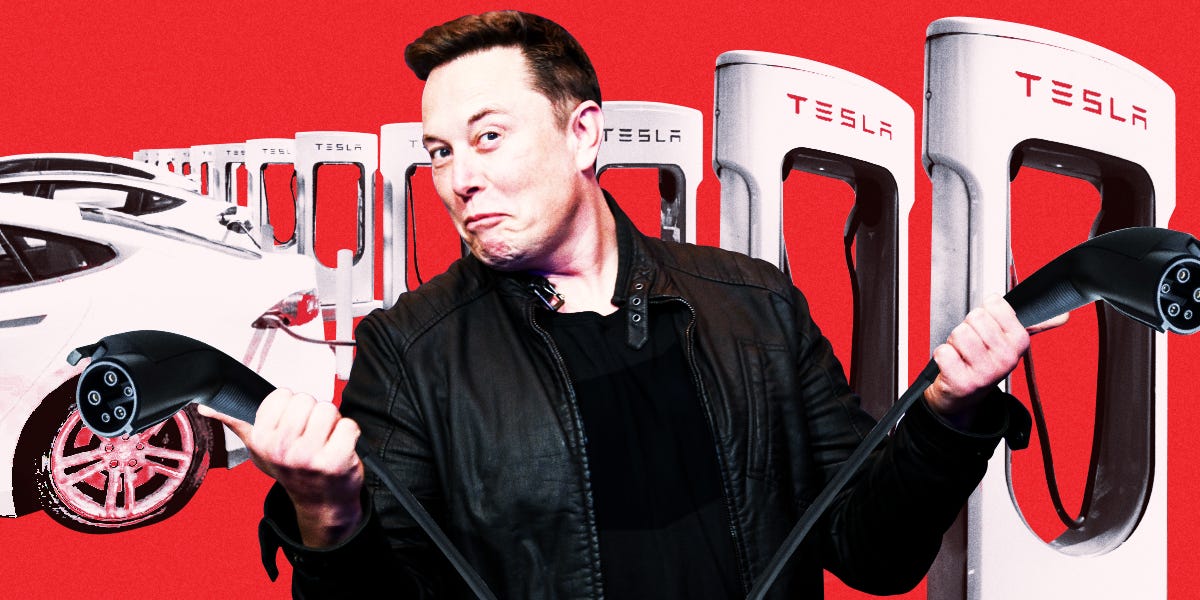Any Mustang Mach-E or Chevy Bolt owner who’s ever driven past a Tesla Supercharger station and turned British Racing Green with envy must be feeling pretty good right now. Last week, Ford and GM announced they had cut deals granting them access to Tesla’s North American Charging System, which is being incorporated into a new industry-wide standard for electric-vehicle charging. Compared with most public charging networks, which use slower “Level 2” chargers, Tesla’s NACS system is lickety-split fast and offers some 20,000 plugs at nearly 1,800 stations in the United States alone.
But that doesn’t answer the question of why Tesla has decided to open the gates to its formerly walled garden of Supercharger stations. It doesn’t seem to be for money — GM and Ford aren’t paying for access, according to early reporting. And the federal government is already including Tesla’s standard in its new $7.5 billion program to encourage charger-network build-out. “Tesla is happy to support other EVs via our Supercharger network,” Tesla CEO Elon Musk tweeted, replying to President Joe Biden’s announcement. So why would the most valuable car company in the world basically give away, for free, one of the things that differentiates it from the automotive hoi polloi?
Look into the business end of a sleek NACS charger, and the answer will be staring you in the face. The charger’s trio of bigger holes are for electricity. But the two smaller ones are data ports. Tesla famously uses cellular and WiFi to collect what one investigation called a “hoard” of data about its cars and users, tracking everything from the efficiency of the braking system to how often drivers use the AC. And the ports on its chargers pull down even more information. Now, by letting Ford and GM plug into its chargers, I think Tesla may be able to siphon off data from its rivals’ cars, too. That would not only give it a market advantage in the auto industry but would also supply the company with a lucrative stream of data it can commoditize and sell to others. In these new charging deals, it looks to me like the real power isn’t in the electrons. It’s in the bits.
Chargers do more than charge
A gasoline pump doesn’t need to know anything more about a car than whether the gas tank is full. In and out, five minutes of liquid flow, and the only evidence left behind is a credit-card number and the delightful aroma of benzene.
But charging electric vehicles is different. Ensuring the optimal health and electrical efficiency of a stack of lithium-ion batteries is arguably the core enabling technical feat of electric cars. There’s a lot of engineering going on in there, but at the most basic level there has to be some communication between the battery management system in the car and whatever’s providing the juice. Sometimes that’s a fairly dunderheaded matter of making sure not to pull more amps than a household line can supply. But faster charging, using direct current, required a more complicated technology to enable the vehicle and the charger to talk to each other about the battery’s needs. That meant including some identifying handshake information and cybersecurity protocols. The Combined Charging System, which is used by pretty much every car company other than Tesla, has plugs for all that — making it bulky and unpleasant to use.
Tesla built a much more streamlined approach. Its charge-carrying pins can handle alternating or direct current, and it includes both a “proximity pilot” for the dumber hi-I-am-here-what-flavor-of-electricity-do-you-need information, and a “control pilot” that can digitally convey all sorts of other information about the car and its driver. The result is a “plug & charge” process that feels even more fire-and-forget than using a gas pump. It also means Tesla gleans a ton of information about its user base every time they charge.
Now, as Fords and Buicks and Chryslers and Volvos start plugging into Tesla’s chargers, analysts I spoke with say the company will almost certainly be able to pull data from rival EVs. For starters, it will collect the state and rate of charge of a car’s batteries. Then, by pairing that data with a driver’s credit-card info and the car’s Vehicle Identification Number, Tesla could effectively perform the equivalent of an ultrasound on the performance of its competitors’ battery systems.
“I suspect that both Ford and GM have set up ways to prevent Tesla from directly harvesting ownership information,” says Mike Ramsey, an automotive analyst with Gartner. “But Tesla could probably figure it out using other means. The data value is mostly internal to Tesla in terms of competitive intelligence.”
Even the most basic information of a charging station — how much juice I need and the best way to give it to me — can be of enormous inferential value, especially when it’s combined with the sociodemographic data anyone could build on the car’s owner from the information needed for payment. It tells you how battery stacks perform over time, what the effects of different use patterns are, maybe even how to think about load planning for the entire electrical grid.
And by tapping into a vehicle’s battery management system, Tesla may be able to get even more data from its competitors. For one thing, as in a Tesla, Ford’s and GM’s systems are on a network that connects battery management, the engine control unit, and a lot more. “If you have access to the battery management system,” says Samrat Acharya, a research engineer who studies EV cybersecurity, “and if you really want to get into the, let’s say, engine-control system, it is not that superhard.”
The future of Tesla
This isn’t about secret technical details. Ford almost certainly knows how a Tesla works; Tesla knows how a Ford works. That’s a simple matter of reverse engineering. But add in the size of the potential dataset that flows through charging plugs, and how that data changes over time, and you could have something really useful. Tesla’s communications folks didn’t respond to my queries, but you know Elon Musk values data. He has said it’s the key to self-driving in Teslas, he started charging researchers for access to data at Twitter, and he’s relying on brain activity data from early Neuralink users to make his brain chips easier to use. For Musk, as for many in Silicon Valley, there’s nothing bigger than Big Data.
Presumably, as other car companies build out their own NACS networks, they’ll be able to siphon similar data from Teslas — which, fair play. But none of them works with data the way Tesla does. While Ford and GM owners have been leery about submitting to the demands of Big Brother, Tesla drivers treat the company as a beloved older sibling, allowing it to collect information about them every time they start their engines.
There were jokes for years that Tesla was actually a carbon-credit company pretending to be a car company. For a while it looked as if it were going to be an insurance company pretending to be a car company. Now, I think it’s going to be a data company — which may just be the thing that winds up keeping it afloat.
Tesla was already chewing through data from its own users to feed its self-driving software, arguably with limited success. Adding battery data from its competitors could, perhaps, help the company improve the efficiency of its own batteries — and therefore the range of its cars, an electric vehicle’s main competitive advantage. Plus, the market for automotive data is large and lucrative. According to The Markup, there are already three dozen companies in a space that some predict could be worth $800 billion by the end of the decade.
And that’s just the beginning. Analysts I spoke with say that data on EV batteries could open up a whole new customer base: electric utilities. Fast charging for electric vehicles increases demand for electricity, and managing that grid right now involves mathematical models and public data. Tesla’s numbers could be the key to figuring out where and when drivers will need power — and where to most profitably put new charging stations, whoever winds up building them. That, in the long run, could prove to be more profitable than actually building and marketing cars. Despite splashy announcements that it was branching out into trucks and a new roadster, Tesla hasn’t released a new model since 2020. Get this data stuff right, and it might not have to.
Adam Rogers is a senior correspondent at Insider.
Read the full article here





